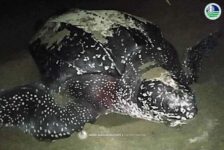
Leatherback sea turtle sighted in SarBay Protected Seascape
A LEATHERBACK sea turtle (Dermochelys Coriacea), the world’s largest species of sea turtle, was spotted for the first time in the Sarangani Bay Protected Seascape (SBPS) along the shores of Barangay Luma in Kiamba, Sarangani Province at 10 p.m. on Saturday, August 31, 2024.
According to a report from the Community Environment and Natural Resources Office (Cenro), the turtle returned to the sea after laying 96 eggs on the beach.
Darwin Diso and Eugene Dave Batadlan, Barangay Luma residents who spotted the turtle, immediately reported the sighting to authorities to ensure the safety of the turtle’s eggs.
To protect the eggs from potential threats, including stray dogs and the effects of rising tides near the nesting site, they were carefully relocated to a nearby temporary hatchery.
An information campaign on proper turtle management and the important role these creatures play in the marine ecosystem was also conducted within the local community to raise awareness about the critical importance of protecting sea turtles and their natural habitat.
Meanwhile, Atty. Felix S. Alicer, regional executive director of the Department of Environment and Natural Resources (DENR-12), praised the strong coordination between the community and local authorities, highlighting their awareness and commitment to conserving marine wildlife species.
“Sarangani Bay is home to various marine turtle species, including green sea turtles, olive ridleys, loggerheads, and hawksbills. The recent sighting and nesting of a leatherback in the protected seascape indicate that the DENR, local authorities, and communities are successfully making the SBPS a haven for these marine species,” Alicer stated.
He also urged the public to assist the DENR in monitoring the nesting site to ensure the eggs’ protection. The incubation period for turtle eggs lasts 75 days before they hatch.
Leatherback turtles, classified as critically endangered by the IUCN Red List of Threatened Species, are recognizable by their black, rubbery skin, pinkish-white underside, and unique shell structure. Unlike other sea turtles, Leatherbacks have a shell composed of interconnected bones covered by skin, setting them apart from other turtle species. EEF



